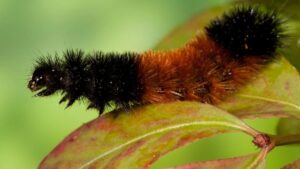On a recent walk with Asa the Pandemic Pup, we noticed the woollies are on the move again.
This time of year, armies of black-and-brown-banded fuzzy caterpillars start crawling across streets and sidewalks everywhere. They are nature’s fastest caterpillars, capable of traveling over a mile a day. So you’ve probably wondered, where are they all headed in such a hurry? What are they all up to?
Well, one thing they are NOT doing is forecasting the winter ahead. We know this because, between 1948 and 1956, the curator of insects at the American Museum of Natural History led a group called the Original Society of the Friends of the Woolly Bear on a little research project. Each year they collected as many woollies as they could and counted how many black segments they had at their ends, versus how many brown segments they had at their middles.
 They postulated that the more brown segments each year’s woollies had on average, the warmer the coming winter would be. Skinny brown section = cold winter; fat brown section = warm winter. Their annual prediction was printed in the New York Herald Tribune. This made woolly bears instant national celebrities. But, unfortunately, this formula has since been discounted as pure folklore.
They postulated that the more brown segments each year’s woollies had on average, the warmer the coming winter would be. Skinny brown section = cold winter; fat brown section = warm winter. Their annual prediction was printed in the New York Herald Tribune. This made woolly bears instant national celebrities. But, unfortunately, this formula has since been discounted as pure folklore.What IS true about woolly bears crossing the road is that they are looking for a good place to freeze. The caterpillars (officially they are the larva of the tiger moth Pyrrharctia isabella) spend the late summer eating weeds like dandelion and clover. As the temperature drops, they look for a nest of organic material under a rock or hard surface to burrow into for the winter.
They then dehydrate themselves and develop a cryoprotectant (a sort of biological antifreeze) that allows them to survive the winter by freezing solid. First their heart stops and freezes, followed by their gut, then the blood, and finally the rest of their body. (Tests have shown that they can survive seven consecutive days in sub-freezing temperatures.) When the Spring comes, they come back to life and pop out of their nests. They eat like crazy, spin a cocoon, and pupate into a tan-yellow moth with dark spots. And start laying eggs to create the next generation.
Woolly bears are adorable. Which explains the Woolly Bear Festivals in Vermilion OH, Banner Elk NC, and Beattyville KY. Folks gather around to watch woolly bears predict the weather (fun, but dopey) and race across stone surfaces (dopey, but fun).
And they are pretty harmless. The fur coat is actually soft hair called setae. Though some folks with sensitive skin can develop a rash after repeatedly touching one, woollies have no toxins or poisons or venom. Nonetheless, you probably shouldn’t let the dog eat one.
Just leave them alone, because if you touch one it just curls up and plays dead until you stop annoying it. And as soon as you are gone, it will be on the move again.
– Mike Keeler
